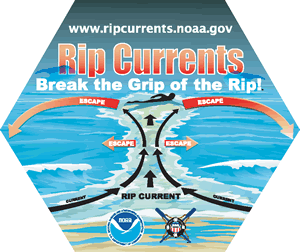
Florida Division of Emergency Management officials are urging beachgoers along the entire Florida Atlantic Coast to use caution as a high risk of dangerous rip currents is expected through Friday. When red flags are flying, beachgoers need to be aware that swimming in the Atlantic Ocean can be dangerous.
“Though Hurricane Katia will remain well offshore of the Florida Coast, large ocean swells from this powerful storm is producing an elevated risk of rip currents along the Atlantic Coast,” said Amy Godsey, State Meteorologist. “Residents and visitors to the Atlantic beaches should check the rip current outlook before heading out and heed any rip current warnings from local officials by knowing the beach warning flag system.”
A rip current is a narrow, powerful current of water that runs perpendicular to the beach, out into the ocean. These currents may extend 200 to 2,500 feet (61 to 762 meters) lengthwise, but they are typically less than 30 feet (9 meters) wide. Also, rip currents can often move at more than 5 miles per hour (8 kilometers per hour) or faster and are not always identifiable to the average beachgoer.
In Florida, rip currents are the number-one concern for beach lifeguards. According to the United States Lifesaving Association, 80 percent of surf beach rescues are attributed to rip currents. The greatest safety precaution that can be taken is to recognize the danger of rip currents and always remember to swim at beaches with lifeguards.
When at the beach:
- Whenever possible, swim at a lifeguard-protected beach.
- Be cautious at all times, especially when swimming at unguarded beaches.
- Obey all instructions and orders from lifeguards. Lifeguards are trained to identify hazards. Ask a lifeguard about the conditions before entering the water. This is part of their job.
- Learn how to swim in the surf. It’s not the same as swimming in a pool or lake. Also, never swim alone.
- Stay at least 100 feet away from piers and jetties. Permanent rip currents often exist alongside these structures.
- Consider using polarized sunglasses when at the beach. They will help you to spot signatures of rip currents by cutting down glare and reflected sunlight off the ocean’s surface.
- Pay especially close attention to children and persons who are elderly when at the beach. Even in shallow water, wave action can cause loss of footing.
If caught in a rip current:
- Remain calm to conserve energy and think clearly.
- Never fight against the current.
- Think of a rip current like a treadmill that cannot be turned off, which you need to step to the side of.
- Swim out of the current in a direction following the shoreline. When out of the current, swim at an angle–away from the current–towards shore.
- If you are unable to swim out of the rip current, float or calmly tread water. When out of the current, swim towards shore.
- If you are still unable to reach shore, draw attention to yourself by waving your arm and yelling for help.
If you see someone in trouble, don’t become a victim too:
- Get help from a lifeguard.
- If a lifeguard is not available, have someone call 9-1-1.
- Throw the rip current victim something that floats–a life-jacket, a cooler, an inflatable ball.
- Yell instructions on how to escape.
- Remember, many people drown while trying to save someone else from a rip current.
Follow safe boating practices:
- Have a VHF Marine Band Radio and NOAA Weather Radio on board.
- Check the marine forecast well ahead of time.
- Know the limitations of your boat. If small craft advisories or gale warnings are issued, you should postpone travel.
- Be sure everyone aboard is wearing a life jacket.
- File a float plan at your marina.
- Thunderstorms and weather-related hazards form quickly. Never let these storms cut off your route back to land.
Beachgoers who want to learn more about rip currents can visit www.ripcurrents.noaa.gov. Boaters can go to www.srh.noaa.gov/wml to check the current marine conditions and updated forecasts. For more information on the Florida Division of Emergency Management and to GET A PLAN!, please visit: www.FloridaDisaster.org. Follow us on Facebook at www.Facebook.com/FloridaSERT and on Twitter at www.Twitter.com/FLSERT.


